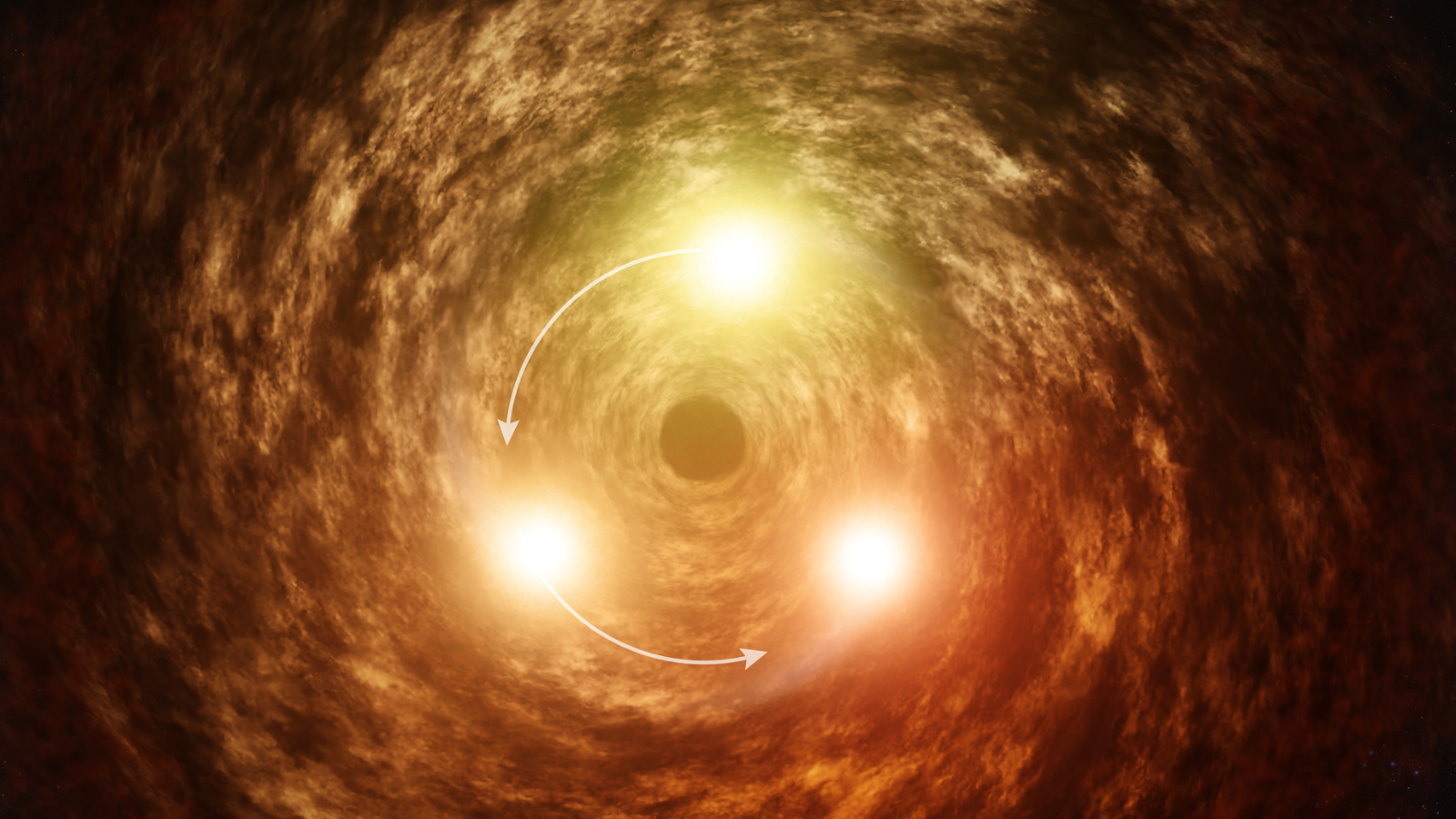James Webb Space Telescope watches our Milky Way galaxy's monster black hole fire out a flare
"In order to get such high sensitivity in the mid-infrared, one needs to go to space, as the atmosphere severely messes up ground-based observations at this wavelength."

Astronomers have used the James Webb Space Telescope (JWST) to observe flares from Sagittarius A*, the supermassive black hole at the heart of the Milky Way, in a new light. The new modelling of these observations could help scientists get to the bottom of how black holes launch these flares, as well as reveal the role magnetic fields play in sculpting matter around these cosmic titans.
The team, including Sebastiano von Fellenberg of the Max Planck Institute for Radio Astronomy in Bonn, Germany, observed flaring from Sagittarius A* (Sgr A*) in the mid-infrared regime for the first time. Flares have been routinely observed in the near infrared regime and in other wavelengths of light before, with each offering a different view of the same flares. That is because all the changes that happen to a black hole flare after its launch and before it fades aren't present in all different wavelengths of light. Thus, observations of a flare in different wavelengths can help better understand the mechanisms black holes use to launch flares and the timescales over which these flares evolve.
Until recently, however, mid-infrared observations have been a missing part of this cosmic jigsaw. Thus, the new James Webb Space Telescope (JWST) observations studied and modeled by the team, first revealed in Jan. 2025, help to bridge the gap in the spectrum of Sgr A* flares between infrared and radio wavelengths: with mid-infrared wavelengths.
"The mid-infrared data is exciting, because, thanks to the new JWST data, we can close the gap between the radio and near infrared regimes, which had been a 'gaping hole' in the spectrum of Sgr A*," von Fellenberg told Space.com. "On the one hand, our mid-infrared flare looks like a typical near-infrared flare, so we now know flares also occur in the mid-infrared regime — and this isn't trivial, as, for instance, the radio variability looks quite different, and we do not see pronounced flare-like peaks in the light curve."
"At the same time," von Fellenberg continued, "the result goes further."
For the first time, he explained, the team was able to observe the source at four different wavelengths simultaneously with a single instrument. This allowed them to measure what's known as the mid-infrared spectral index.
Getting to the bottom of black hole flaring
One of the most famous aspects of black holes is that they are bounded by an outer region called an "event horizon" at which the gravitational influence of a black hole becomes so great that not even light moves fast enough to escape its grip and takes a one-way trip to the singularity at its heart. This means black holes emit no light, or electromagnetic radiation.
Breaking space news, the latest updates on rocket launches, skywatching events and more!
To be fair, this may make it seem a little odd to study Sgr A*, a black hole with a mass equivalent to that of over 4 million suns, in any wavelengths of electromagnetic radiation.
However, our galaxy's central supermassive black hole does regularly burp out flares of light. Quite what causes these "burps" isn't yet known, but simulations of supermassive black holes have indicated that it may be the result of interactions between surrounding magnetic fields. When magnetic field lines touch and connect, a vast amount of energy is released and, as a byproduct, this releases a type of radiation called "synchrotron radiation."
The fact that the mid-infrared spectral index of the Sgr A* flare changes over the outburst's lifetime revealed to the team that a phenomenon called "synchrotron cooling" is occurring around Sgr A*. Synchrotron cooling happens when high-speed electrons lose energy by emitting that aforementioned synchrotron radiation. This energy is powering the observed mid-infrared emissions.
"In the absence of high-sensitivity multi-frequency observations, the presence of this expected behavior hadn't been confirmed before," von Fellenberg said. "What is cool about this is that since the speed of this cooling, the cooling time scale, depends on the magnetic field strength, we can now measure it for the given flare."
The researcher explained that though the magnetic field strength had been measurable with near-infrared flares, those measurements didn't allow scientists to measure it independently from other parameters, such as the total number of electrons in the region of the emission.
"This new way of determining the magnetic field strength is particularly useful as it's quite 'clean' in that not a lot of assumptions have to go into the measurement," von Fellenberg continued. "This is very useful for theoretical models, which are poorly constrained in that regard for Sgr A*, because magnetic field strengths are quite important."
The scientists explained that these observations wouldn't have been possible without the JWST, and, in particular, the Medium-Resolution Spectrometer (MRS) operating mode of its Mid-Infrared Instrument (MIRI).
"In order to get such high sensitivity in the mid-infrared, one needs to go to space, as the atmosphere severely messes up ground-based observations at this wavelength," von Fellenberg said. "In addition, the MIRI/MRS instrument is the first instrument to give you such broad wavelength coverage for Sgr A*, a prerequisite to measure the spectral index, so it's really a double whammy!"
The team's research is available on the paper repository site arXiv, with two companion papers also published to the site.

Robert Lea is a science journalist in the U.K. whose articles have been published in Physics World, New Scientist, Astronomy Magazine, All About Space, Newsweek and ZME Science. He also writes about science communication for Elsevier and the European Journal of Physics. Rob holds a bachelor of science degree in physics and astronomy from the U.K.’s Open University. Follow him on Twitter @sciencef1rst.
You must confirm your public display name before commenting
Please logout and then login again, you will then be prompted to enter your display name.